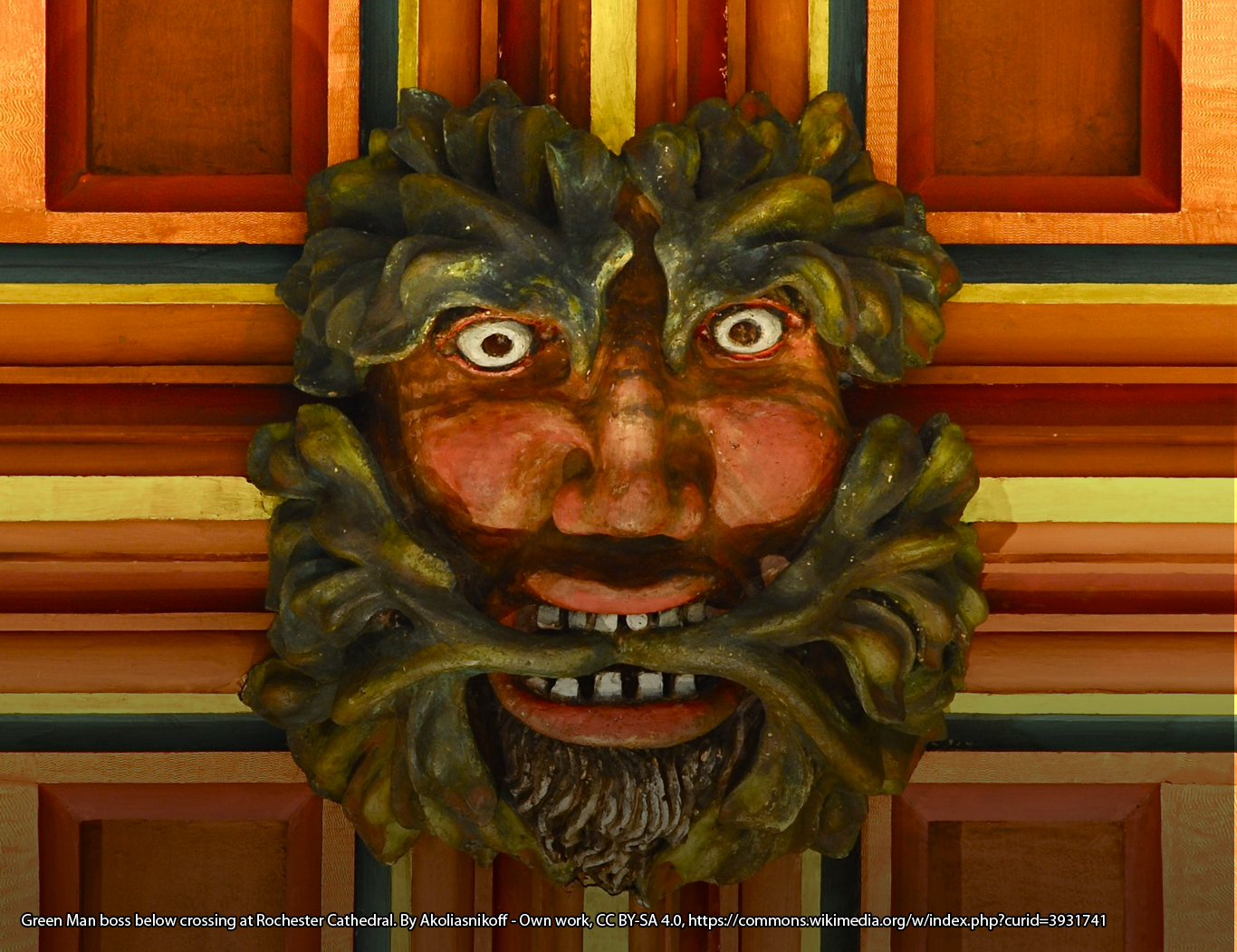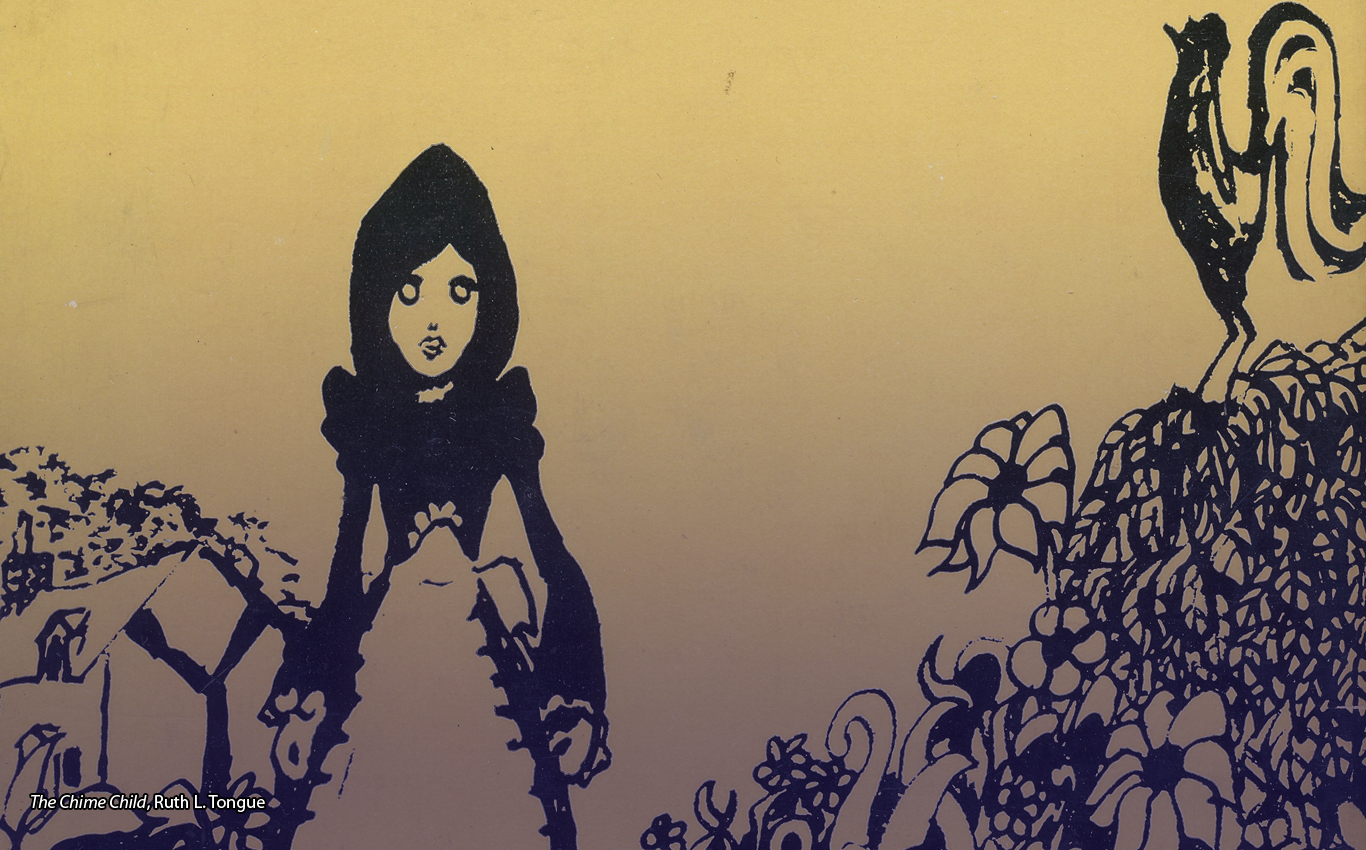I was once in charge of a baby in a cathedral. Time passes slowly when you’re only one year old, and there was an hour to go until the christening, so we set off down the aisles in search of distraction. Though spiritual matters were still a closed book to him, we were happy with the dogs and dragons under the feet of long-dead knights, while the monkey on the corbels was met with a squeal of delight, and I blessed the old masons who had carved so much living nature in the pale stone. Foliage, however artistic, was met with indifference until I pointed out a head hidden in the leaves, and then we played peek-a-boo finding faces for so long that we were almost late for the main event.
Finding Green Men in medieval churches was a game for myself and my young charge; others have made it an all-engrossing spiritual quest. Deep things have been said about the head in the leaves: he is a trickster, a prophet, the guardian and revealer of mysteries. Well, maybe. Let’s start with the obvious. The Green Man is a carving in which the human face is combined with leaves and branches. You can call him the foliate head if you like, but this is just variation, a jargon which is less important than the facts. More useful is the distinction between two kinds of heads: leaf-masks, where the features of his face actually grow into leaves, and disgorging heads, where branches and greenery sprout from his mouth.

The Green Men that you find in British churches will be either Romanesque, from the twelfth century, or Gothic, from the thirteenth to the early sixteenth. A handful of earlier figures have survived on the Continent, among them the fourth-century tomb of St. Abre at Poitiers, the third-century sarcophagi now at the Rheinisches Landesmuseum, and a second-century head from a Gallo-Roman temple relocated to Trier Cathedral. So clearly the foliate head in both forms, disgorging and leaf-mask, was known to Roman sculptors, and it was their work that survived to inspire medieval artists. Which is hardly surprising, because the idea of stone-carving itself came from the Mediterranean world, along with the revival of stone-masonry. We tend to crop our photos of Green Men to leave out the building around them, but they are really architectural motifs: they belong on the capitals at the top of pillars, on the corbels that hold up ribs, on the bosses where the ribs join. You don’t see free-standing Green Men, except on the terracotta souvenirs in the cathedral gift shop.
Carving a realistic face with leaves isn’t easy – carving anything isn’t easy, when you’ve never done it before – and a lot of Norman sculpture looks like the work of hopeful locals. Luckily for them, the Romanesque aesthetic is very two-dimensional, more like drawing than modelling. Even the best of the early Green Men, the one by the door at Kilpeck, could have been sketched out on the stone and then cut away in relief. He’s a disgorging head because this type is much easier to produce if you’re shaky on faces. These Romanesque heads often take their inspiration from manuscripts with what are called cat-masks, a sort of all-purpose animal head with lines (you can hardly call them foliage) coming out of one mouth and joining up with another: there’s a good set on the capitals of the crypt at Canterbury.
The technical breakthrough, in the 1230s or thereabouts, was undercutting, which models the stone in three dimensions, not just as a flat view. Whereas Romanesque leaves are splayed around the head, the Gothic ones surround and cover it, with a real human face underneath; this is the period when leaf-masks flourish. To appreciate this, you need to go to the great churches – Ely, Exeter, Winchester, Norwich – which supported dynasties of talented carvers.
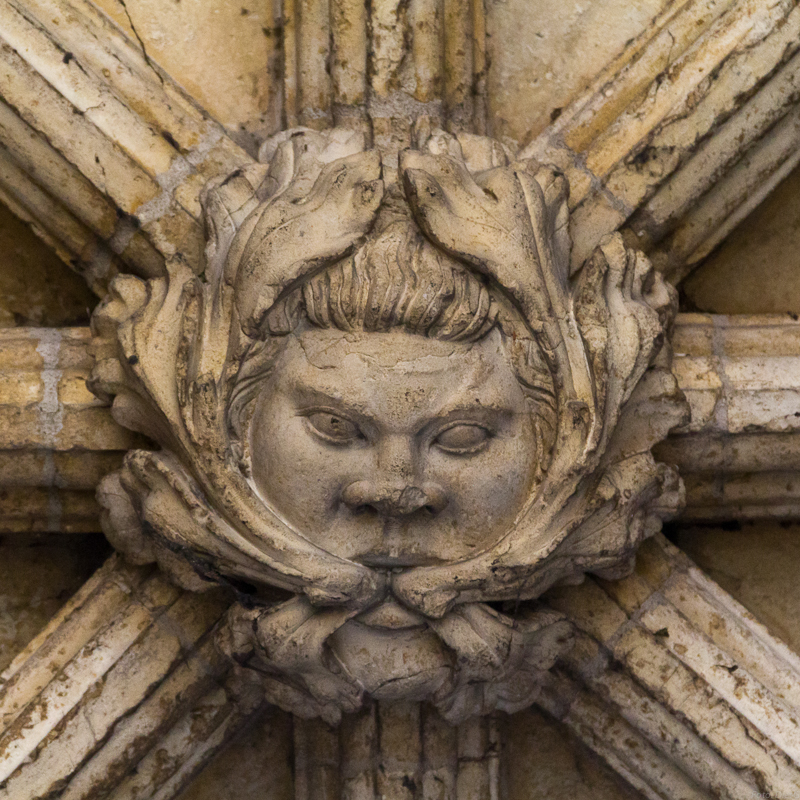
Some of these carvings look like people that you’d recognise if you met them in the street (alright, minus the leaves). But this is just a trick. Medieval carvers didn’t work from life – when they wanted to portray a face with foliage, they didn’t walk out of the mason’s lodge, pick a branch off a tree, and really look at what was there. Instead the Green Men are surrounded by a conventional leaf, usually lobed, preferably with three lobes. That means vine, hop, ivy, hawthorn, and maple, in descending order of popularity, down to unrecognisable growths. By the fifteenth century a standard lobed leaf had replaced all these, because it filled the corners of a square so nicely. The woodcarvers came from another school, and because they normally worked in oak, they liked the trick of carving it into oak leaves (still lobed, but with five or seven, not three). These are often accompanied by acorns – there’s a nice one in the choir seats at Lincoln – but as you go down the ladder of competence it gets more and more difficult to distinguish acorns from hops from bunches of grapes.
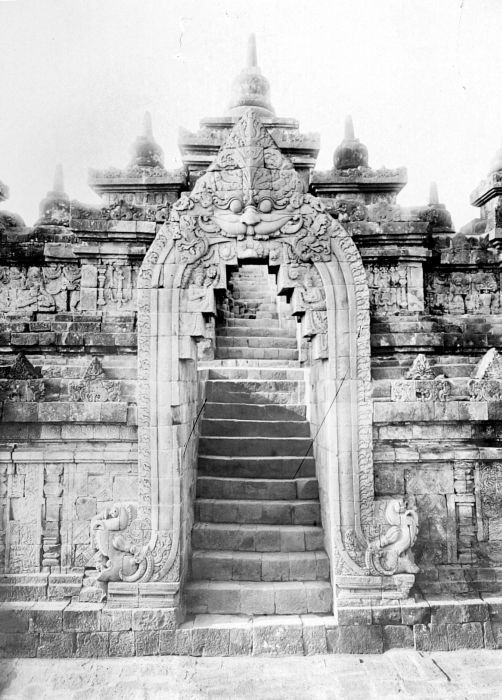
Maybe the craftsmen couldn’t tell, or maybe they didn’t care; they were often copying from patterns anyway. Mercia MacDermott has shown that the earliest Romanesque disgorging heads are influenced by copies of copies of Indian art showing the kirttimukha and the makara. The travelling mason Villard de Honnecourt kept a notebook in the 1220s in which he sketched four ideas for leaf-masks, which he calls têtes de feuilles. This is a lucky survival but there must have been other others. Some fifteenth-century Green Men, for example, have a little three-leafed spray growing up from the nose out over the forehead. You see it in Norwich, you see it in the amazing roof-bosses of Rosslyn chapel, and it must have travelled from one to the other in the pages of a sketchbook.
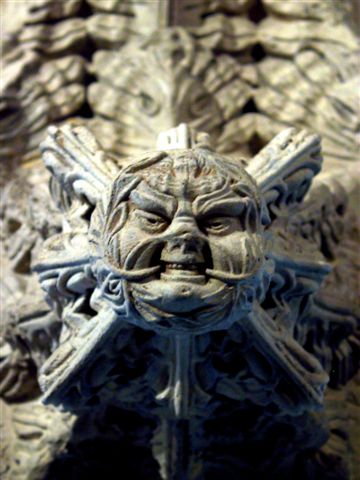
Which means that these Green Men were imagined in pen and ink, not polychrome. Medieval bosses tend to get repainted, so we don’t know the original colour scheme. At Exeter and Pershore the heads are surrounded by acanthus, which would be a silvery colour. Elsewhere, it might have been brown rather than green: after all, the leaves are typically accompanied by fruit – acorns, haws, grapes – which belong to autumn rather than spring. The majestic head at Sutton Benger is framed by birds picking at the berries. Flowers do make an appearance in the Chapter House at Southwell, where a remarkable series of foliate heads is carved with buttercups, cinquefoil and bryony, along with the usual maple and hawthorn. But the Southwell masons were exceptional in choosing wild variety over stereotype.
The portraiture of Green Men tends to follow the conventions of the time; young faces with flowing locks give way to mature bearded figures as the fourteenth century follows the thirteenth. The later ones have the pudding-basin haircut of Henry V, or are bald and stern. In the last years of medieval art, some faces appear with wimples and headdresses, but the earlier heads are always men. This seems more odd to us than it would have to the masons, who lived in a men-only society.
Leaf masks are typically calm, the face flat and tranquil as the leaves rise out of it, though the roof bosses at Norwich have flared wild eyes which suggest something more sinister. A gentle or unearthly smile often shows under the fronds, though of course it’s easy to smile if you you’re not chewing a mouthful of branches at the same time; the disgorging heads are more restless. Some of them have lips pursed into a figure-of-eight; some are trying to bite at the proliferating stems; some have a line of snarling piano-key teeth. Sometimes, as the fourteenth century wears on, we find figures resigned in a horrible passivity to shoots sprouting out of their eyes. Others scowl, or poke their tongues out. We find the snub noses, wide eyes and unkempt hair which typified the churl and the giant.
So that’s what Green Men look like. But what do they mean? Surely, we feel, they must mean something. So much medieval art is didactic. If you see a dignified figure carrying his head in front of him, it’s St. Nectan or St. Decuman. If the severed head is on a platter with a halo round it, it’s St. John the Baptist. But of course we know what these images mean because there are written texts to go with them. Nothing was ever written about heads sprouting foliage. We don’t know what they were called at the time (‘Green Man’ is just a label made up by Lady Raglan in a paper of 1939 in Folk-Lore). In fact we don’t know that they were called anything.
Janet Dowling has ingeniously proposed that they illustrate the old legend of the ‘Tree of Mercy’, in which Adam grows old and his son Seth is given pips from the tree in the Garden of Eden, and told to put them under the tongue of his dying dad. Then when Adam is buried, a tree grows out of his grave and…. well, it’s a long story, but the wood of this tree ends up being used as the Cross of Christ. As a symbolic story, this is tops, but unfortunately it was made up more than a century after the initial popularity of Green Men. Also, as we have seen, their foliage isn’t necessarily arboreal; trees take their place alongside leafy shrubs, creepers and sometimes flowers. It’s not as if there was an otherwise unrecorded Buttercup of Mercy.
Was there a spiritual significance to Green Men? Or, for that matter, to any of the other hundred grotesque motifs in church decoration? One summer I read a fourteenth-century book of edifying preachers’ stories called Fasciculus Morum, which means the Secateurs of Sin. Even at the end of three hundred pages I was not edified, but that may not be the fault of the Fasciculus: anyway, I can assure you it made no mention at all of church carvings. Which is odd if these had really had a story to tell. Most public speakers like visual aids.
And on the other hand, many of these motifs appear on misericords, the little hinged seats which supported the clergy singing in choir. These are great fun – go and look at them in Cartmel, Winchester, Lincoln and Beverley, if the vergers will let you, and you will find carvings of Green Men alongside animal fables, household quarrels, fantastical creatures, knights in armour, footballers, elephants… in short, whatever took the fancy of the carvers. No spiritual significance at all: and the range of character is just as wide as in stone-carving. There are foliate heads that look elfin, wise, otherworldly, sad, sinister, diabolical, brutal and threatening – everything that can imagined if you put together the two ideas of ‘greenwood’ and ‘face’. This does not suggest a single, universally understood meaning for the figure.
Of course we look for Green Men in churches, because churches are the largest surviving medieval buildings which are open to the public today. But they appear in secular buildings as well, especially when these have undercrofts with roof bosses. This suggests that their purpose was decorative, rather than didactic. The curious thing is that you don’t find Green Men outside carvings. Almost never in stained glass; never, as far as I know, in illuminated manuscripts. And yet they would have been so easy to draw, and a natural subject if they had some symbolical importance. The exception here is the school of embroidery called Opus Anglicanum, fantastically expensive in its day, and now almost lost because textiles are so fragile. The fourteenth-century Steeple Ashton Cope has diamond-shaped foliate masks at the joins of oak branches. On the Vic Cope, the Green Men appear as if they were on square roof bosses, which must be where the embroiderers got the idea. Evidently it was a specific craft tradition for them, as it was for the stone-masons, a challenge to get the mix of leaves and face just right.

So what did the carvers intend as they chipped away in the chilly mason’s lodge? Were they representing people that they’d seen dressed up in green branches for some May-Day custom? That would give the carvings a context in real contemporary folklore, but it’s not likely. Foliate heads have all sorts of unrealistic features, like leaves growing from skin; the rare full-length figures aren’t dressed in greenery; and the foliage isn’t necessarily springtime, and doesn’t always come from trees. So were the cunning old masons carving Green Men for didactic purposes, to remind viewers of life’s deepest roots and restore their harmony with the natural world? That would have been an odd sort of message to give medieval people. What we call the natural world was, in those days, just the world – there was no other, and they didn’t need to be reminded to live in it.
That’s all very well, you may think, but what do these carving have to say to us? What is their message?… No, hang on a minute. These carvings weren’t meant for us. They were set up five, six, seven hundred years ago for reasons that seemed good at the time but which didn’t have anything to do with an unthinkably remote posterity. The true meaning of the Green Man – if there was a meaning at all, and the evidence rather suggests that there wasn’t – must be the meaning that he had there and then.
Yes, it is possible, and it may be profitable, to write about the Green Man, not historically but in an archetypal way: as if the actual foliate heads that you see in chapter houses and cloisters were just pale reflections of some really real Green Man who exists outside space and time and who also manifests over the centuries as Robin Hood, Robin Goodfellow, the Jack-in-the-Green, the Green Knight, etc. etc. Some people relish this sort of thing. I can’t see the point in it myself.
Some further reading
The queen of Green Man studies is Ruth Wylie, who has seen and photographed more of these heads than anyone else, and who supplied pictures for the best book on the subject, Mercia MacDermott’s Explore Green Men (Heart of Albion, 2003). A good general survey, mixed up with lots of greenish folklore, is Fran and Geoff Dowell’s The Green Man in Britain (Tempus, 2001). I wrote The Green Man for Pitkin in 2001 and Mike Harding, a whizz with a camera when he’s away from the day job, brought out A Little Book of the Green Man for Aurum in 1998. The classic original study is Kathleen Basford’s The Green Man (D.S. Brewer, 1978). There’s also William Anderson’s Green Man – The Archetype of our Oneness with the Earth (Harper Collins, 1990) and John Matthews’ The Quest for the Green Man (Godsfield, 2001) for those who like that way of thinking.

